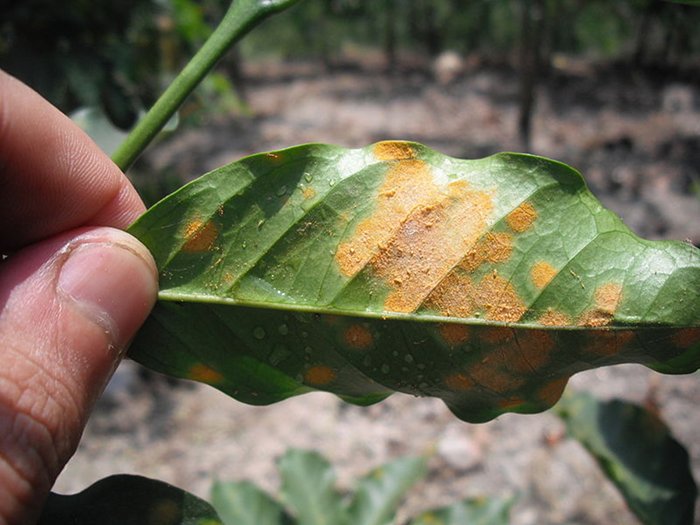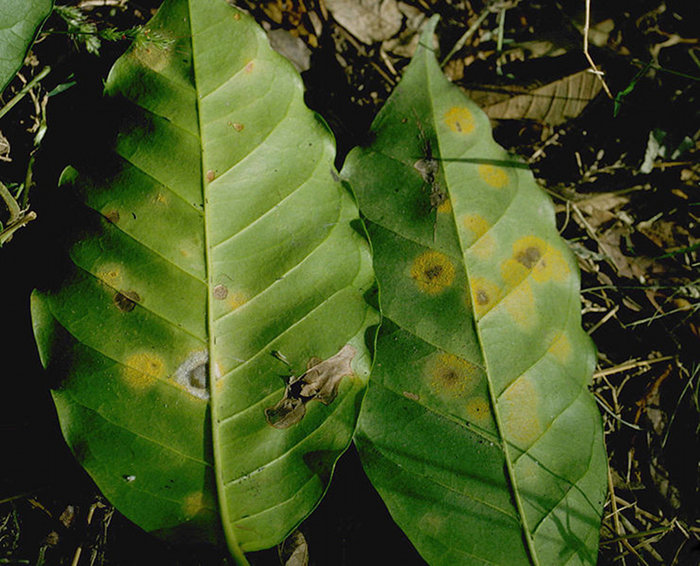
In the last 2-3 years we have seen a shortage of Colombian coffee that has contributed to the high Colombian differentials (prices) and also has contributed to the worldwide coffee shortage, being the world’s largest washed coffee producer. All of the above has also had an impact in the prices of the coffee worldwide (Coffee “C” Market).
Healthy coffee shrub
Roya (rust) targets the physiological development of the coffee shrub and its production. Its propagation is correlated with high rain levels, temperature/humidity relation and lower altitudes among other factors. The shrub will loose most of its leaves and the maturation of the coffee fruit will halt and being unable to ripen. Finally the stems will dry out and rust will be evident. Roya has devastated plantations and this is why it is such a problem. In recent studies it has destroyed about 30% of the production in certain areas.
Traditionally Colombia has grown varieties such as Typica, Borbon and Caturra. These varieties are good in the cup but have some pitfalls. They are prone to get infected by the rust fungus (Hemileia vastarix). Roya hit hard for the first time in 1970 in Brazil. As a reaction to roya the FNC (National Federation of Coffee Growers in Colombia) developed Variedad Colombia in 1982 and improved it until the year 2005. Variedad Colombia is derived from Hibrido de Timor, an Arabica x Robusta natural hybrid. You might be familiar with Catimor, a hybrid of Hibrido de Timor x Caturra that is resistant to roya. In 2005 CENICAFE started to develop Variedad Castillo. Castillo is also derived from Hibrido de Timor and is resistant to roya, has a larger bean size and is more productive. As of now about ¾ of coffee in Colombia is susceptible to rust hence this is one of the main problems for coffee cultivation in Colombia. Variedad Colombia and Castillo are not 100% immune to rust but the incidence is so low it really is not worth treating since it happens at very low levels.
Coffee shrub (left) attacked by roya
Many farmers do not take precautions to prevent rust and try to address it when it has already attacked their plantation. At this point it is too late to fix the problem and will most likely have a noticeable reduction on production. Between 2008 and 2010 Colombia has suffered their most recent roya outbreak.
Some coffee plants might be more prone to disease than others. Some of these factors are: limited development of root systems, excess water in soil and nutrition deficiencies due to lack of fertilization. In order for rust to spread there has to be water (rain) splashing from leaf to leaf, ambient temperatures between 16°C and 28°C and low sunlight. The FNC has recommended, historically, to plant coffee at 1,600+ masl (meters above sea level) in areas with an average temperature of 19°C. In the past years we have seen erratic or unusual weather patterns causing coffee within these ranges to be affected when they weren’t in the past. From 2008 to 2010 Colombia has seen an increase of about 40% in precipitation and has maintained a relative humidity level of at least 85% for many months. The previous conditions are perfect for fungus propagation. The following departments were affected by roya even at altitudes between 1600 and 2000 masl: Huila, Caldas and Quindio. This is something I was able to experience first hand when visiting Huila and Caldas a couple of weeks ago.

Roya
There are certain man-made practices that contribute to the propagation of roya. Weeding the areas where coffee is grown is key. Too many weeds will compete with the coffee plant for nutrients, create humid conditions and even provide too much shade (plants 2 years and younger). Not applying fertilizers or not enough will affect plants with a great deal of sunlight because they need more nutrients. Excessive shade will create humid conditions due to tighter minimum and maximum temperatures. High number of plants per hectare will create a good environment for roya growth. In Colombia they plant about 6,000 shrubs/hectare which is extremely high compared to half or less at other origins in Central America for example.
As a preventive measure it is necessary to use fungicides on coffee shrubs. There are different types of fungicides that can be used. It is necessary for the farmer to determine which one is the best one. It is very important to apply the fungicide at the right time. The FNC provides a calendar to farmers with suggested time frames for fungicide application. These have to be applied from 2 – 4 times a year. Coffee growers can also apply fungicides based on flowering cycles. Finally, growers could also apply fungicides depending on the severity of roya. All of the above are different methods that can be used to counter act roya.
